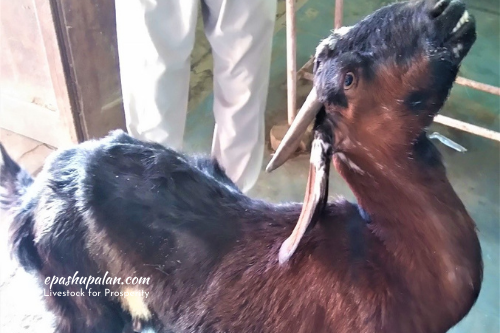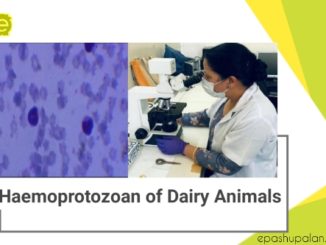Polioencephalomalacia (PEM)
In the tribal areas of India goat rearing is one of the major livestock rearing activities. Since the animals are generally reared in a non-intensive system there may be a high incidence of Polioencephalomalacia (PEM) in the goats of these areas. This leads to huge economic losses to the tribals which is why knowledge about this disease is of utmost importance especially because there is not much awareness regarding PEM.

Aetiology
PEM is an important neurological disease of goats. The disease is seen either sporadically or as a herd outbreak. In general younger animals are more frequently affected than adults. PEM has been associated with two types of dietary risks: altered thiamine states and high sulphur intake, out of which the former is more commonly encountered in Indian conditions.
Thiamine inadequacy can be caused by such factors as acute dietary deficiency of thiamine or ingestion of plant thiaminases or thiamine analogues. A potential mechanism of thiamine inadequacy is the action of thiaminases or thiamine in the GI tract. Thiaminases can be produced by gut bacteria or ingested as preformed plant products at the time of grazing/ browsing. Certain thiaminase producing microorganisms also proliferate under conditions of high grain intake.
Clinical findings
Signs are neurological in origin. Goats usually begin to wander aimlessly, sometimes in circles, or stand motionless and are blind, but within a few hours they become recumbent with opisthotonus (star gazing), extension of the limbs, hyperesthesia, nystagmus, and periodic tonic-clonic convulsions. Occasional animals show ataxia, staggering, hypermetric gait and hind limb paresis. Head pressing and teeth grinding are common.
Diagnosis
No biochemical test for the diagnosis of PEM is practically possible to perform. The pattern of clinical signs should arouse suspicion of the disease. The readily available simple tests which rule out other diseases that resemble PEM along with a careful consideration of the epidemiological history assists in the diagnosis. A beneficial response to thiamine therapy by PEM affected animals is may also be considered evidence of thiamine inadequacy, but with caution.
Differential diagnosis
The disease must be differentiated from caprine leukoencephalomyelitis, listeriosis, enterotoxemia, pregnancy toxemia, lead poisoning and meningoencephalitis.
Treatment
The treatment of choice for thiamine deficiency PEM is thiamine hydrochloride @ 10 mg/ kg BW IV initially and followed by similar doses every 3 hours for a total of 5 treatments. When treatment is given within a few hours of the onset of signs, a beneficial response within 1-6 hours is common and complete clinical recovery can occur in 24 hours. For those which take longer to recover, the eyesight and mental awareness will gradually improve in a few days and the animal will usually begin to eat and drink by the third day after treatment. Treatment is ineffective in advanced cases. The oral administration of thiamine or thiamine derivatives @ 1 g is indicated when thiaminases are thought to be in the alimentary tract.
Control
A rational approach to the control of PEM associated with thiamine inadequacy is to supplement the rations of goats with thiamine @ 3 mg/ kg DM of feed, on a continuous basis.
|
The content of the articles are accurate and true to the best of the author’s knowledge. It is not meant to substitute for diagnosis, prognosis, treatment, prescription, or formal and individualized advice from a veterinary medical professional. Animals exhibiting signs and symptoms of distress should be seen by a veterinarian immediately. |






Be the first to comment